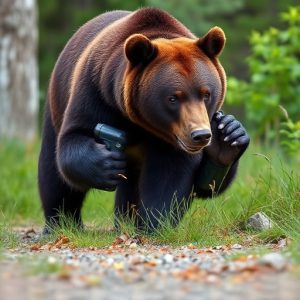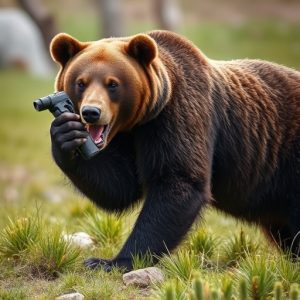Bear Spray 101: Legalities, Choice, Use, and Real-World Effects
Bear spray, a powerful deterrent against bear attacks, relies on capsaicin and other ingredients to…….
Bear spray, a powerful deterrent against bear attacks, relies on capsaicin and other ingredients to create an irritating mist. Its use is heavily regulated, with restrictions varying by region due to its potency. Understanding local laws regarding bear spray possession and types of bears in your area is crucial for safe usage. Effectiveness requires proper spraying techniques at a distance of 20-30 feet, aiming for the bear's face and eyes. Bear spray is prohibited in many national parks and some urban areas to protect wildlife and prevent misuse.
“Bearing the brunt of a bear attack can be devastating, making the right prevention tools crucial. This article delves into bear spray—a popular yet misunderstood deterrent. We explore its effectiveness and various types available in the market. Understanding legal restrictions on where bear spray is prohibited is essential for responsible use.
Key factors guide the selection of suitable equipment, while proper usage techniques ensure maximum protection. Real-life encounters will illustrate success stories and lessons learned, highlighting the importance of informed decision-making when it comes to bear attack prevention spray.”
- Understanding Bear Spray: Effectiveness and Types
- Legal Considerations: Where Bear Spray is Prohibited
- Key Factors in Choosing the Right Bear Spray Equipment
- Proper Usage Techniques to Maximize Protection
- Real-World Scenarios: Success Stories and Lessons Learned
Understanding Bear Spray: Effectiveness and Types
Bear spray, also known as bear repellent, is a crucial tool for preventing attacks from bears, especially in areas where human-bear encounters are common. Its effectiveness lies in its ability to create an irritating mist that deters bears when they come into contact with it. When sprayed directly towards a bear, the capsaicin (a chemical found in chili peppers) and other ingredients in the spray can temporarily blind and irritate the bear’s eyes, nose, and respiratory system, causing the animal to flee.
There are various types of bear spray available on the market, each with different concentrations and features. These include legal considerations regarding their use, as some areas have restrictions or outright prohibitions on carrying bear spray. Always check local regulations before purchasing or using any form of bear repellent. Some popular options include canister sprays, hand-held aerosoids, and even non-lethal firearms equipped with specialized rounds designed to deter bears without causing harm.
Legal Considerations: Where Bear Spray is Prohibited
In many regions, bear spray is a highly regulated item due to its potent nature and potential impact on both wildlife and humans. While it’s widely recognized as an effective prevention tool against bear attacks, certain areas have strict laws prohibiting its possession or use. National parks and wilderness reserves often ban bear spray to maintain the ecological balance and prevent any disruption to wild animal behavior. This is particularly common in places where grizzly bears or black bears are known to roam.
Moreover, some cities and towns located within bear country may also restrict or prohibit the carrying of bear spray by civilians. These restrictions aim to avoid accidental misuse, ensure public safety, and reduce potential conflicts between humans and bears. It’s crucial for individuals planning outdoor activities in bear-inhabited areas to familiarize themselves with local laws regarding bear spray possession and usage before heading into the wilderness.
Key Factors in Choosing the Right Bear Spray Equipment
When selecting bear spray equipment, several key factors come into play. Firstly, understand the local regulations and where bear spray is prohibited. Some areas have strict rules due to environmental or human safety concerns, so checking regional guidelines is essential. Secondly, consider the type of bears you’re likely to encounter; black bears and grizzly bears (brown bears) behave differently, influencing the choice of spray type and concentration.
The effectiveness of bear spray depends on factors like can size, nozzle type, and spray pattern. Larger cans offer more protection but may be bulkier, while smaller ones are easier to carry but have shorter ranges. Nozzle types vary, affecting spray distribution; some are designed for wide areas, while others focus the spray in a narrow beam. Understanding these variations ensures you pick the right equipment tailored to your specific needs and environment.
Proper Usage Techniques to Maximize Protection
To maximize protection against bear attacks, it’s crucial to understand and employ proper usage techniques for bear spray equipment. First, ensure you’re within the effective range of the spray—typically around 20-30 feet (6-9 meters). Start with a wide stance, point the nozzle away from yourself, and towards the approaching bear, then activate the spray in one steady stream directly into the wind, aiming for the bear’s face and eyes. Coughing or creating a gust of wind can help ensure full coverage of the spray.
Remember, bear spray is most effective when used early during an encounter. Avoid turning away or running, as this might trigger an attack. Instead, make yourself appear larger by raising your arms or jacket, speak firmly, and back away slowly while spraying. It’s also important to note where bear spray is prohibited—in some areas, it’s not allowed for recreational use due to environmental concerns or specific regulations. Always check local guidelines before venturing into bear country.
Real-World Scenarios: Success Stories and Lessons Learned
In real-world scenarios, bear spray has proven to be an effective prevention tool in many instances. Success stories abound from hikers and campers who found themselves face-to-face with bears. In most cases, the mere presence of the spray and its distinct scent deterred the attack, allowing individuals time to escape or climb a tree. These anecdotes highlight the importance of carrying bear spray when venturing into known bear habitats, especially where prohibited areas exist for other uses like hunting or recreation.
Lessons learned from these encounters emphasize the need for proper training on how and when to use bear spray. Some prohibitions around bear spray usage are in place due to concerns over misuse or in environments where bears are not typically aggressive. Understanding local regulations is crucial, as using bear spray inappropriately can have adverse effects on both humans and wildlife. Therefore, users must be knowledgeable about the specific areas where bear spray is allowed and learn best practices for its application to ensure safety without causing unintended harm.
Bear spray equipment is a valuable tool for outdoor enthusiasts navigating bear country, but it’s crucial to understand its limitations. While effective in deterring bears, legal restrictions on where bear spray is permitted vary widely, with some areas prohibiting its use entirely. Choosing the right spray requires considering factors like can size, spray pattern, and active ingredients. Proper usage techniques, including target practice and understanding the spray’s range, are essential for maximizing protection during encounters. By staying informed about local regulations and practicing responsible bear spray use, individuals can enhance their safety in bear habitats while contributing to the preservation of these wild animals.


